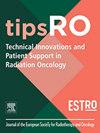Training for tomorrow: Establishing a worldwide curriculum in online adaptive radiation therapy
IF 2.8
Q1 Nursing
Technical Innovations and Patient Support in Radiation Oncology
Pub Date : 2025-02-05
DOI:10.1016/j.tipsro.2025.100304
引用次数: 0
Abstract
This commentary discusses the implementation of online adaptive radiation therapy (oART) in cancer treatment within the context of current challenges faced by radiation therapy professionals. oART enables modifications to treatment plans based on daily imaging, enhancing target accuracy while minimising harm to surrounding organs. Despite its potential to improve patient outcomes, the application of oART is hindered by notable barriers, particularly in human resources. A global shortage of skilled radiation professionals such as radiation therapists or therapeutic radiographers (RTTs), medical physicists and radiation oncologists, along with training challenges in online adaptive techniques, hinders oART implementation and sustainability. Moreover, geographical disparities limit access to advanced training programs, leaving RTTs and their patients in underserved regions at a disadvantage. There is growing global evidence that RTTs are being successfully trained to lead adaptive fractions in both cone-beam computed tomography and magnetic resonance imaging guided oART. This commentary proposes the notion of standards for a global training curriculum to address barriers and expand RTT capabilities in delivering oART. By leveraging artificial intelligence and fostering interdisciplinary collaboration, the radiation therapy field can enhance efficiency and accuracy in oART. Successful training models from leading institutions illustrate the importance of hands-on experience and ongoing mentorship. A coordinated effort among stakeholders is essential to establish a comprehensive global training framework, ultimately improving patient access to oART and elevating standards of care worldwide.
面向未来的培训:建立在线适应性放射治疗的全球课程
这篇评论讨论了在当前放射治疗专业人员面临挑战的背景下,在线适应性放射治疗(oART)在癌症治疗中的实施。oART可以根据日常成像修改治疗计划,提高目标准确性,同时最大限度地减少对周围器官的伤害。尽管有可能改善患者的预后,但oART的应用受到明显障碍的阻碍,特别是在人力资源方面。全球缺乏熟练的放射专业人员,如放射治疗师或放射治疗技师(rtt)、医学物理学家和放射肿瘤学家,以及在线适应技术方面的培训挑战,阻碍了oART的实施和可持续性。此外,地域差异限制了获得高级培训项目的机会,使服务不足地区的rtt及其患者处于不利地位。越来越多的全球证据表明,rtt正在成功地训练,以引导锥束计算机断层扫描和磁共振成像引导的oART中的自适应分数。本评注提出了全球培训课程标准的概念,以解决提供抗逆转录病毒药物治疗方面的障碍并扩大RTT的能力。通过利用人工智能和促进跨学科合作,放射治疗领域可以提高oART的效率和准确性。来自领先机构的成功培训模式说明了实践经验和持续指导的重要性。利益攸关方之间的协调努力对于建立一个全面的全球培训框架至关重要,从而最终改善患者获得抗逆转录病毒药物治疗的机会并提高全世界的护理标准。
本文章由计算机程序翻译,如有差异,请以英文原文为准。
求助全文
约1分钟内获得全文
求助全文
来源期刊

Technical Innovations and Patient Support in Radiation Oncology
Nursing-Oncology (nursing)
CiteScore
4.10
自引率
0.00%
发文量
48
审稿时长
67 days
 求助内容:
求助内容: 应助结果提醒方式:
应助结果提醒方式:


